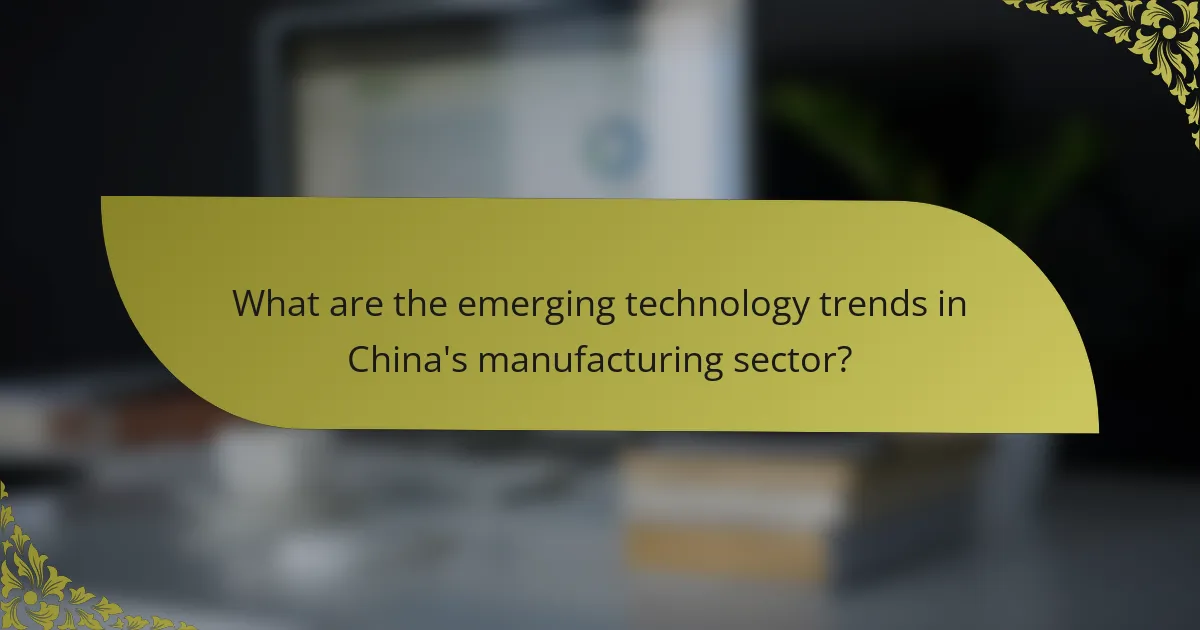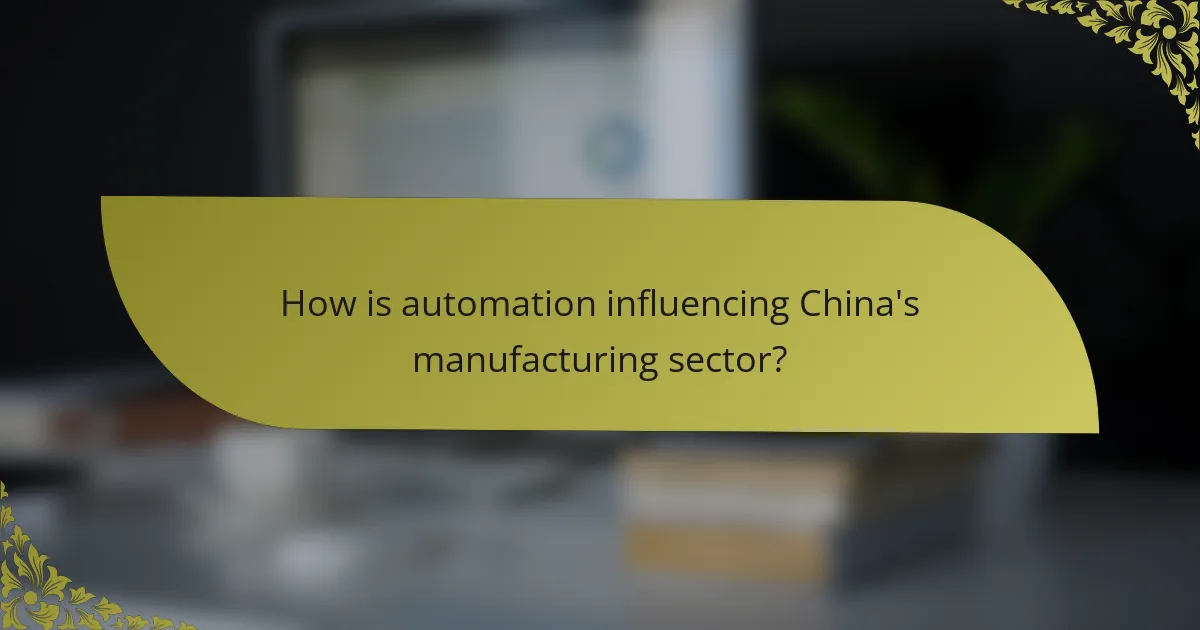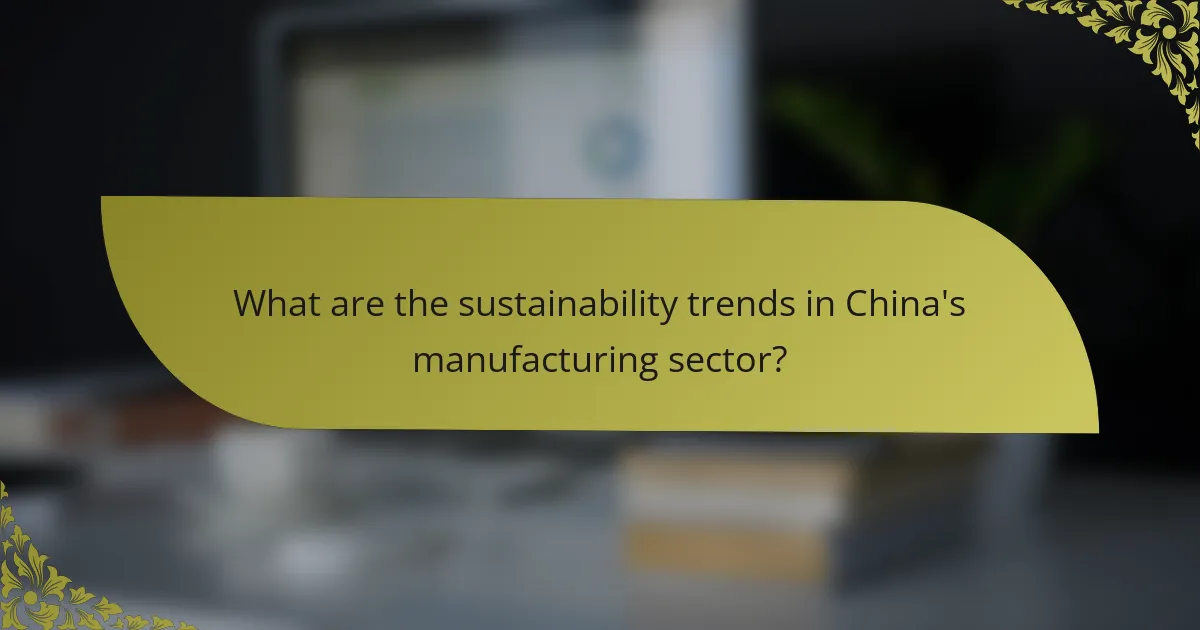The article explores emerging technology trends in China’s manufacturing sector, focusing on automation, artificial intelligence (AI), and the Internet of Things (IoT). Automation enhances production efficiency and reduces labor costs, while AI applications improve quality control and predictive maintenance. The IoT enables real-time data collection, facilitating smarter manufacturing processes. Additionally, the article highlights the increasing use of advanced robotics and the shift towards sustainability, including the integration of renewable energy and energy-efficient technologies. These trends are essential for achieving high-quality growth and enhancing competitiveness in the global manufacturing landscape.

What are the emerging technology trends in China’s manufacturing sector?
Emerging technology trends in China’s manufacturing sector include automation, artificial intelligence, and the Internet of Things (IoT). Automation enhances production efficiency and reduces labor costs. AI applications in manufacturing improve quality control and predictive maintenance. The IoT facilitates real-time data collection and analysis, leading to smarter manufacturing processes. Additionally, advanced robotics are increasingly used for precision tasks. According to the China Manufacturing 2025 initiative, these technologies are vital for achieving high-quality growth in the sector. The integration of these technologies is expected to significantly boost productivity and innovation within China’s manufacturing landscape.
How are these trends reshaping the manufacturing landscape?
Emerging technology trends are significantly reshaping the manufacturing landscape in China. Automation and artificial intelligence are enhancing production efficiency. For instance, factories are adopting robotics for repetitive tasks, reducing labor costs. The integration of IoT devices allows real-time monitoring of manufacturing processes. This leads to improved quality control and reduced downtime. Additionally, additive manufacturing, or 3D printing, is enabling rapid prototyping and customization. According to a report by McKinsey, companies implementing these technologies can increase productivity by up to 30%. These trends are driving a shift towards smart manufacturing, fostering innovation and competitiveness in the sector.
What specific technologies are leading the change in China’s manufacturing?
Artificial intelligence, advanced robotics, and the Internet of Things (IoT) are leading the change in China’s manufacturing. These technologies enhance efficiency and productivity. Artificial intelligence optimizes supply chain management and predictive maintenance. Advanced robotics automates repetitive tasks, reducing labor costs. The IoT connects machines and systems for real-time data analysis. This integration allows for smarter decision-making and resource allocation. According to a report by McKinsey, AI could add $1.5 trillion to $2 trillion in value to China’s manufacturing sector by 2030. These technologies are transforming traditional manufacturing into smart manufacturing.
How do these technologies improve efficiency and productivity?
Emerging technologies in China’s manufacturing sector improve efficiency and productivity by automating processes and optimizing resource use. Automation reduces human error and speeds up production rates. Technologies such as AI and machine learning analyze data for better decision-making. This leads to more accurate forecasting and inventory management. Robotics enhance precision in tasks like assembly and welding. IoT devices enable real-time monitoring of equipment, reducing downtime. According to a report by McKinsey, companies that adopt these technologies can increase productivity by up to 30%. Overall, these advancements streamline operations and reduce costs.
What role does government policy play in these emerging trends?
Government policy significantly influences emerging technology trends in China’s manufacturing sector. Policies drive innovation by providing funding and incentives for research and development. For example, the “Made in China 2025” initiative aims to upgrade manufacturing capabilities through advanced technologies. This initiative encourages investments in robotics, AI, and big data analytics. Furthermore, government regulations can shape industry standards and promote sustainable practices. The Chinese government has set targets for reducing carbon emissions in manufacturing, pushing companies to adopt greener technologies. These policies not only stimulate economic growth but also enhance global competitiveness.
How is the Chinese government supporting technological advancements in manufacturing?
The Chinese government is supporting technological advancements in manufacturing through various initiatives. It has implemented the “Made in China 2025” strategy to promote high-tech industries. This strategy focuses on innovation, research and development, and the adoption of advanced technologies. Financial support is provided to companies investing in automation and smart manufacturing. The government also encourages collaboration between universities and industries. This collaboration aims to enhance workforce skills and drive technological innovation. Additionally, tax incentives are offered to firms that invest in new technologies. According to the Ministry of Industry and Information Technology, these efforts aim to transform China into a global manufacturing powerhouse.
What incentives are provided for adopting new technologies?
Incentives for adopting new technologies in China’s manufacturing sector include financial subsidies, tax breaks, and grants. The Chinese government offers these incentives to encourage innovation and modernization. For instance, the Ministry of Industry and Information Technology announced a 10 billion yuan fund to support advanced manufacturing. Additionally, companies that invest in research and development can receive a 75% tax deduction on R&D expenses. These measures aim to enhance competitiveness and drive economic growth.
What challenges do manufacturers face in adopting emerging technologies?
Manufacturers face several challenges in adopting emerging technologies. High initial costs for investment in new technologies can deter adoption. Limited access to skilled labor also complicates the integration of advanced systems. Resistance to change within organizations often hampers the implementation process. Additionally, manufacturers must navigate complex regulatory environments, which can slow down technology adoption. Data security concerns pose significant risks, as new technologies may expose vulnerabilities. Lastly, the rapid pace of technological advancement makes it difficult for manufacturers to keep up and ensure compatibility with existing systems.
What are the financial implications of implementing new technologies?
Implementing new technologies in manufacturing has significant financial implications. These implications include initial capital expenditure, ongoing operational costs, and potential savings. Initial investment can be substantial, often requiring funds for equipment and training. However, new technologies can lead to increased efficiency and productivity, which can offset these costs over time.
For instance, automation can reduce labor costs and minimize errors, resulting in higher output. A study by McKinsey & Company indicates that automation can increase productivity by up to 30%. Additionally, advanced technologies can lead to lower energy consumption, further reducing operational costs.
Over time, the return on investment can be realized through enhanced competitiveness and market share. In summary, while initial costs are high, the long-term financial benefits can be substantial.
How do skill gaps among the workforce affect technology adoption?
Skill gaps among the workforce significantly hinder technology adoption. When employees lack the necessary skills, they struggle to effectively utilize new technologies. This leads to decreased productivity and efficiency. A 2021 study by McKinsey found that 87% of companies reported skill gaps affecting their digital transformation efforts. Additionally, organizations may face increased costs due to the need for extensive training programs. The inability to adapt can result in a competitive disadvantage in the rapidly evolving manufacturing sector. Thus, addressing skill gaps is crucial for successful technology integration.

How is automation influencing China’s manufacturing sector?
Automation is significantly transforming China’s manufacturing sector. It enhances efficiency by streamlining production processes. Automation reduces labor costs by minimizing the need for manual labor. This shift allows companies to allocate resources to more strategic areas. Robotics and artificial intelligence are increasingly integrated into manufacturing lines. According to the International Federation of Robotics, China is the largest market for industrial robots, with over 140,000 units sold in 2020. Automation also improves product quality through consistent precision. Furthermore, it enables manufacturers to respond quickly to market demands. These advancements position China’s manufacturing sector for greater competitiveness on a global scale.
What types of automation technologies are being implemented?
Robotic process automation (RPA), artificial intelligence (AI), and machine learning are types of automation technologies being implemented. RPA automates repetitive tasks, improving efficiency in manufacturing processes. AI enhances decision-making by analyzing data and predicting outcomes. Machine learning enables systems to learn from data, optimizing production lines. Additionally, industrial robots are increasingly used for assembly and material handling. Automated guided vehicles (AGVs) transport materials within facilities, reducing human labor needs. These technologies collectively contribute to increased productivity and cost savings in China’s manufacturing sector.
How do robotics and AI enhance manufacturing processes?
Robotics and AI enhance manufacturing processes by increasing efficiency and precision. Robotics automates repetitive tasks, reducing human error. AI analyzes data to optimize production schedules. Together, they improve operational speed and reduce waste. According to a McKinsey report, AI can increase manufacturing productivity by up to 20%. Robotics can operate 24/7, ensuring continuous production. This leads to higher output and lower labor costs. In China, these technologies are crucial for maintaining competitive advantage in global markets.
What are the implications of automation on employment in the sector?
Automation in China’s manufacturing sector significantly impacts employment. It often leads to job displacement, particularly for low-skilled workers. A report by McKinsey Global Institute estimates that up to 73 million jobs could be lost by 2030 due to automation. However, automation also creates new job opportunities in technology and maintenance. The demand for skilled workers in programming and robotics increases. Companies may need to invest in retraining programs for the existing workforce. This dual effect of job loss and creation shapes the future employment landscape. Ultimately, the implications of automation require careful consideration of workforce adaptation strategies.
How does Industry 4.0 integrate into China’s manufacturing?
Industry 4.0 integrates into China’s manufacturing through advanced technologies like IoT, AI, and big data analytics. These technologies enhance production efficiency and product quality. For example, IoT devices monitor equipment performance in real-time. This leads to predictive maintenance, reducing downtime and operational costs. AI algorithms optimize supply chain management and production schedules. Big data analytics enables manufacturers to make data-driven decisions. China’s government supports this integration with initiatives like “Made in China 2025.” This initiative aims to transform the manufacturing sector into a more innovative and high-tech industry. The integration of these technologies positions China as a global leader in smart manufacturing.
What are the key components of Industry 4.0 in manufacturing?
The key components of Industry 4.0 in manufacturing include the Internet of Things (IoT), artificial intelligence (AI), big data analytics, and automation. IoT enables interconnected devices to communicate and share data in real-time. AI enhances decision-making processes through machine learning and predictive analytics. Big data analytics processes vast amounts of data to identify trends and optimize operations. Automation streamlines manufacturing processes, increasing efficiency and reducing human error. These components collectively transform traditional manufacturing into smart factories, driving productivity and innovation in the sector.
How does data analytics contribute to smarter manufacturing decisions?
Data analytics enhances smarter manufacturing decisions by providing actionable insights from data. It allows manufacturers to analyze production processes in real-time. This leads to increased efficiency and reduced waste. For instance, predictive analytics can forecast equipment failures before they occur. According to a report by McKinsey, companies using data analytics can reduce manufacturing costs by up to 20%. Analytics also helps in optimizing supply chain management. By analyzing data trends, manufacturers can better align inventory with demand. This results in improved customer satisfaction and reduced stockouts. Overall, data analytics transforms raw data into strategic decision-making tools in manufacturing.

What are the sustainability trends in China’s manufacturing sector?
China’s manufacturing sector is increasingly adopting sustainability trends. These trends include the integration of renewable energy sources, such as solar and wind power, into production processes. Companies are also implementing energy-efficient technologies to reduce consumption. The use of recycled materials in manufacturing is on the rise. Additionally, there is a growing focus on reducing carbon emissions and waste. Regulations are driving manufacturers to adopt sustainable practices. For instance, the Chinese government has set ambitious targets for carbon neutrality by 2060. These initiatives are supported by investments in green technologies and innovation. Overall, sustainability is becoming a core aspect of China’s manufacturing strategy.
How are manufacturers adopting green technologies?
Manufacturers are adopting green technologies by implementing energy-efficient processes and sustainable materials. Many companies are investing in renewable energy sources like solar and wind. This shift helps reduce carbon emissions significantly. For example, a report by the China National Energy Administration shows that solar energy usage in manufacturing increased by 30% in 2022. Additionally, manufacturers are utilizing waste recycling systems to minimize environmental impact. This approach not only conserves resources but also lowers production costs. Many firms are also embracing smart manufacturing technologies to optimize energy consumption. Data from the Ministry of Industry and Information Technology indicates that smart factories can reduce energy use by up to 20%. Overall, these initiatives reflect a commitment to sustainability in China’s manufacturing sector.
What specific practices are being implemented to reduce environmental impact?
Manufacturers in China are implementing several specific practices to reduce environmental impact. These practices include adopting cleaner production technologies. Companies are also shifting towards renewable energy sources, such as solar and wind power. Waste reduction strategies are being integrated into production processes. Additionally, many manufacturers are enhancing energy efficiency in operations. The use of eco-friendly materials is increasingly prioritized. Water conservation measures are being established to minimize resource depletion. Finally, companies are investing in carbon capture technologies to mitigate greenhouse gas emissions. These practices collectively contribute to a more sustainable manufacturing sector.
How do these practices affect operational costs and efficiency?
Emerging technology practices in China’s manufacturing sector significantly reduce operational costs and enhance efficiency. Automation and robotics streamline production processes, minimizing labor costs. Smart manufacturing technologies enable real-time monitoring, leading to reduced downtime and waste. Data analytics improve decision-making, optimizing resource allocation. According to a report by McKinsey, companies adopting advanced technologies can reduce costs by up to 30%. Additionally, the integration of IoT devices allows for predictive maintenance, further lowering maintenance costs. Overall, these practices lead to improved productivity and cost-effectiveness in manufacturing operations.
What best practices can manufacturers follow to stay competitive?
Manufacturers can stay competitive by adopting advanced technologies and optimizing processes. Implementing automation increases efficiency and reduces labor costs. Utilizing data analytics enhances decision-making and improves product quality. Embracing sustainability practices can attract environmentally conscious consumers. Investing in employee training ensures a skilled workforce capable of handling new technologies. Collaborating with tech firms can foster innovation and access to cutting-edge solutions. Regularly assessing market trends helps manufacturers adapt to changing consumer demands. These practices are essential for maintaining a competitive edge in the evolving manufacturing landscape.
How can companies effectively integrate new technologies into their operations?
Companies can effectively integrate new technologies into their operations by adopting a structured approach. This includes assessing current processes and identifying areas for improvement. They should engage stakeholders early in the integration process. Training employees on new technologies is crucial for successful adoption. Companies must also establish clear goals for technology implementation. Continuous monitoring and evaluation of technology performance help in making necessary adjustments. Research shows that companies that invest in employee training see a 24% increase in productivity. A study by McKinsey found that organizations that prioritize technology integration can achieve up to 30% higher operational efficiency.
What strategies can be employed to overcome resistance to change?
Effective strategies to overcome resistance to change include clear communication, involvement, and support. Clear communication helps stakeholders understand the reasons for change. Involvement encourages participation in the change process. Support systems provide resources and assistance during transitions. Training programs enhance skills and confidence among employees. Leadership commitment is crucial for demonstrating the importance of change. Recognizing and addressing concerns fosters a positive environment. Feedback mechanisms allow for adjustments based on employee input. These strategies lead to smoother transitions and greater acceptance of changes in organizations.
The main entity of this article is ’emerging technology trends in China’s manufacturing sector.’ The article examines key advancements such as automation, artificial intelligence, and the Internet of Things (IoT), highlighting their roles in enhancing production efficiency, reducing labor costs, and facilitating real-time data analysis. It discusses the impact of government policies, including the “Made in China 2025” initiative, on promoting technological adoption and sustainability practices. Additionally, the article addresses challenges manufacturers face in integrating these technologies and the implications for employment and operational costs, ultimately emphasizing the importance of innovation for maintaining competitiveness in the manufacturing landscape.



